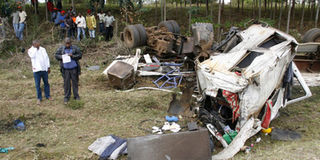Residents blame truck drivers for fatal accidents at Salgaa black spot

PHOTO | SULEIMAN MBATIAH Some of the vehicles involved in an accident at Salgaa on Nakuru-Eldoret highway on May 11, 2014.
What you need to know:
- Agency plans to install speed cameras along stretch to curb carnage
- The notorious section stretches from Kibunja to Salgaa shopping centre. It includes Jolly Farm, Mkinyai and Migaa and Sachangwan, where an oil tanker accident several years ago killed nearly 200 people.
The mention of the name Salgaa sends a chill down the spine of every motorist and traveller along the Nakuru-Eldoret highway.
Scores of people have died and many others have sustained serious injuries in accidents along an 11-kilometre stretch in the area.
The notorious section stretches from Kibunja to Salgaa shopping centre. It includes Jolly Farm, Mkinyai and Migaa and Sachangwan, where an oil tanker accident several years ago killed nearly 200 people.
Despite the deaths and injuries, and several campaigns to contain road accidents, motorists still speed on the dangerous stretch.
Drivers, including those with many years of experience behind the wheel, drive with little respect for other road users.
According to data from the Traffic Police Department, 71 people have lost their lives at the spot since the beginning of the year, with more than 300 being seriously injured.
The records show that in 2013 alone, 27 accidents occurred, with 45 people killed and 56 sustaining serious injuries.
In 2012, the script was not any different as 40 people died.
Rift Valley Regional Traffic Enforcement Officer Mary Omari, appealed to motorists to be careful when driving along the killer stretch.
“Motorists must observe traffic rules and exercise caution all the time,” she said.
“It seems the stretch is cursed. Not a week passes without an accident happening,” said Mr Patrick Rotich, a resident of Mkinyai.
Most of the residents feel that the fatal crashes are caused by trucks as they descend the steep stretch.
“Most lorries are driven without the gears engaged in a bid to save on fuel, which drivers normally sell at Salgaa trading centre,” said Ms Jacinta Awuok, a sugar cane trader at Kibunjia.
According to residents, the practice poses danger to other road users. It has been the major cause of fatal accidents in the area.
“Some motorists straddle the yellow line that divides the road for descending and ascending vehicles. In so doing, they collide with innocent drivers keeping to the left,” said Ms Awuok, adding that by not engaging gears downhill, it becomes difficult for the drivers to apply emergency brakes.
EXERCISE DUE CARE
According to Ms Awuok, the only way to curb road carnage is for drivers to exercise due care while driving along this section.
“The accidents are avoidable. I don’t understand why motorists continue to put people’s lives at risk by being reckless. They know this road has killed many and will continue to claim more if we are not cautious,” she said.
National Transport Safety Authority (NTSA) chairperson Lee Kinyanjui said that a 24-hour speed camera would be installed at the stretch to ensure heavy commercial vehicle drivers do not drive with the gears disengaged.
He warned that those who will be caught engaging in the practice will have their driving licences revoked permanently.
“Those caught must be dealt with decisively to reduce the number of road accidents that have claimed numerous lives,” he said.
He recommended a new route for trucks along the stretch.
Dark patches of spilt oil, broken glasses, pieces of rubber and mangled remains of motor vehicle parts litter the road section, a grim reminder that the stretch bears a bitter past for many families.
In January 2009, an oil tanker overturned just 300 metres from Salgaa trading centre, eventually resulting in the death of 347 people.
The victims had rushed to the scene to scoop oil when the tanker burst into flames.
Ms Susan Nyaboke, whose husband narrowly escaped death in the Sachangwan tragedy, urged the public to avoid scooping oil in tanker accidents.
“The fire consumed many of those who had emerged from their houses with containers and hosepipes, ready to siphon the fuel,” she said.
Not a month passes without the road stretch claiming lives. Ironically, there are several points for traffic officers on the stretch.
ROAD SIGNS STOLEN
A spot check along the section shows that most of the road signs have been stolen by some residents for sale to scrap metal dealers.
However, NTSA Director General Francis Meja last week said that new road signs, guard rails and road markings at the stretch would be in place within the next two weeks. He warned that anyone found vandalising road signs and guard rails would be punished severely.
“The community must take a proactive stance on the road signs. Let those vandalising them be punished accordingly,” he said.
Former Makueni district commissioner Kigen Kipkorir died at the Salgaa black spot when his vehicle collided head-on with a speeding oil tanker.
Residents said some of the truck drivers will be tired and sleepy, a situation that leads to accidents.
“The brakes fail whenever the drivers attempt to slow down or stop the loaded trucks,” said Mr James Kariuki, a mechanic at the Salgaa trading centre.
Mr Salim Bakari, a matatu driver, said some accidents are caused by trucks parked along the road.
“The truck drivers don’t care. They just park and even stop in the middle of the road without warning,” said Mr Bakari.





